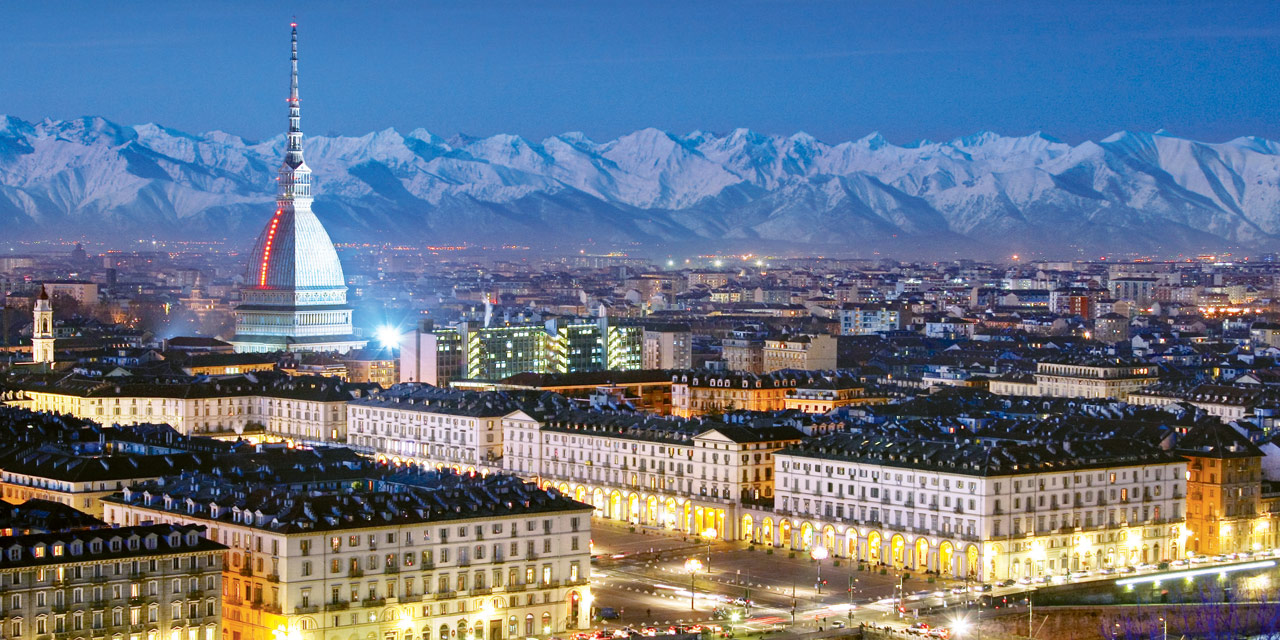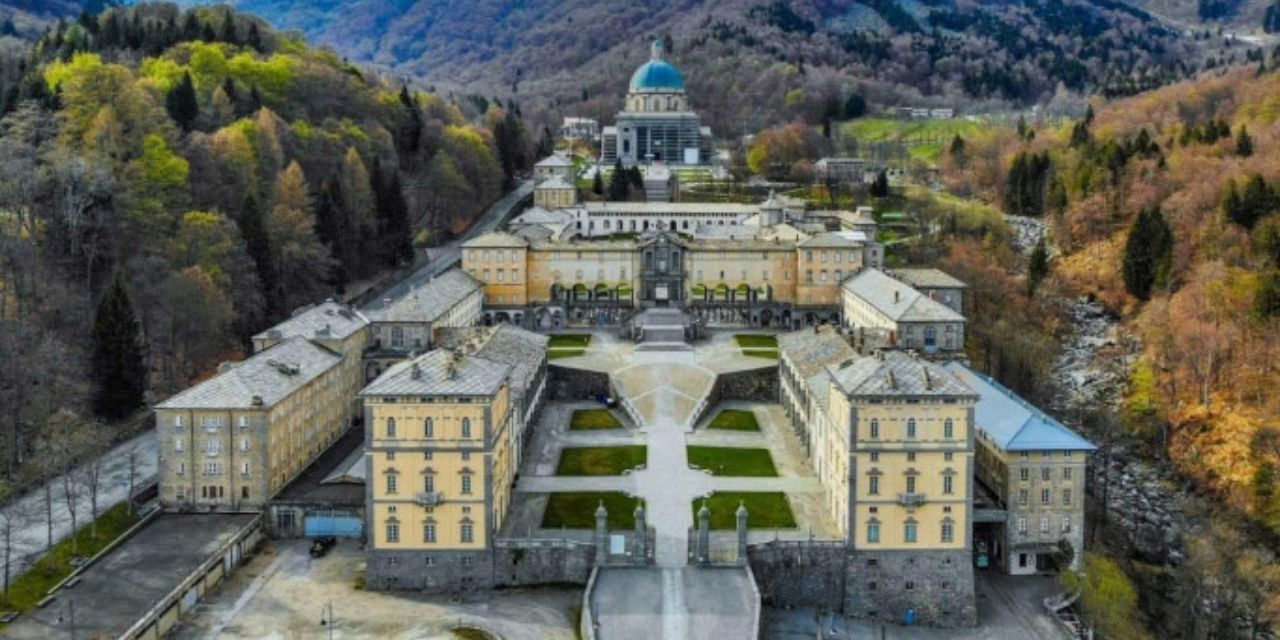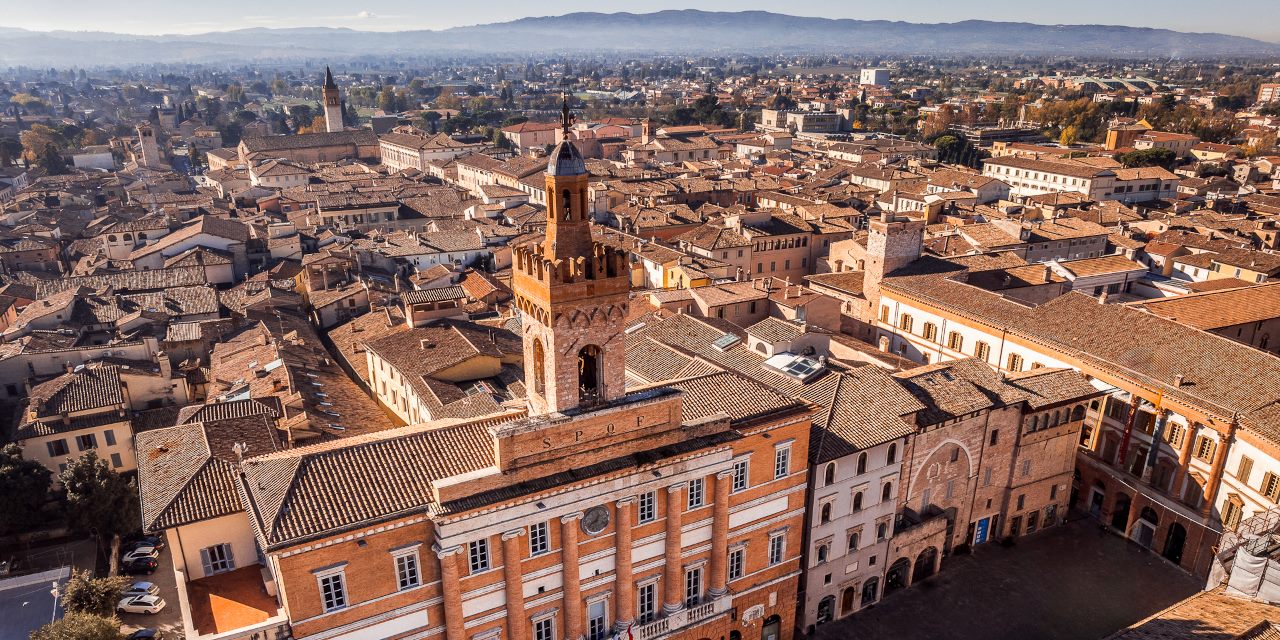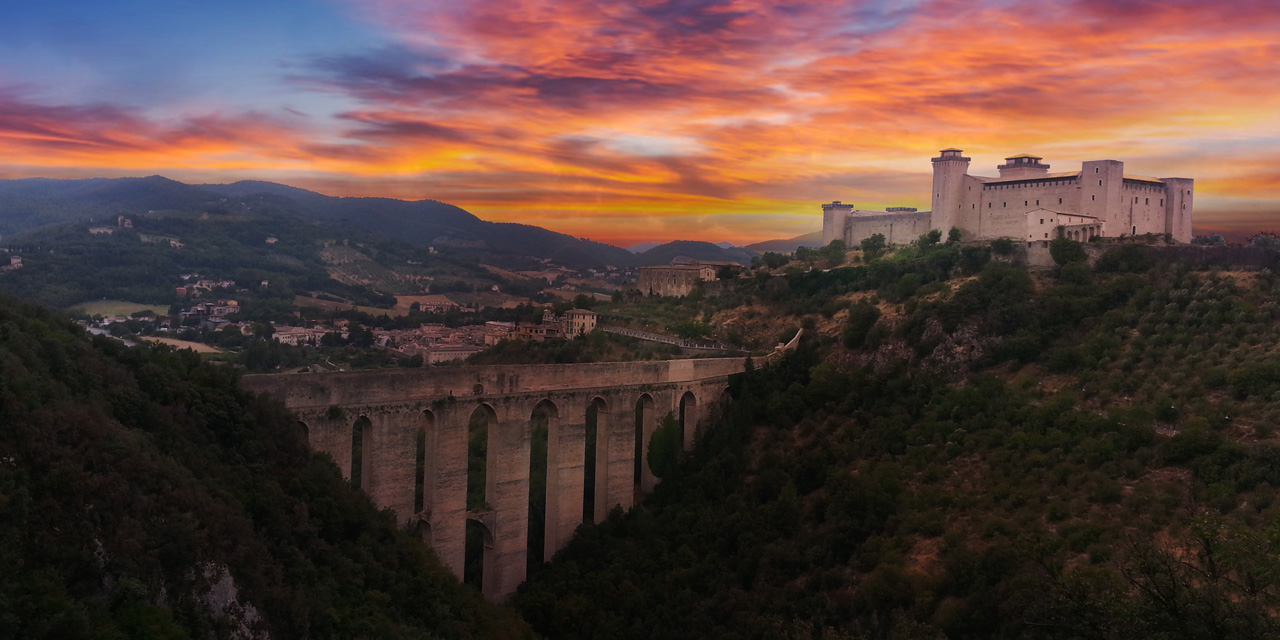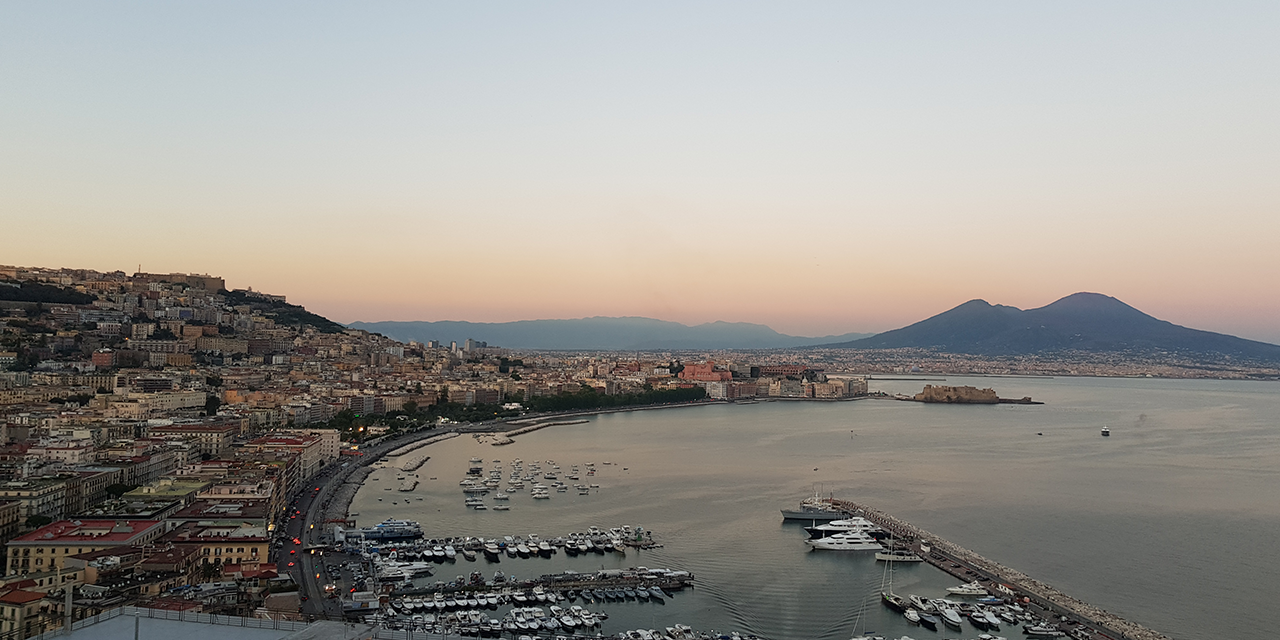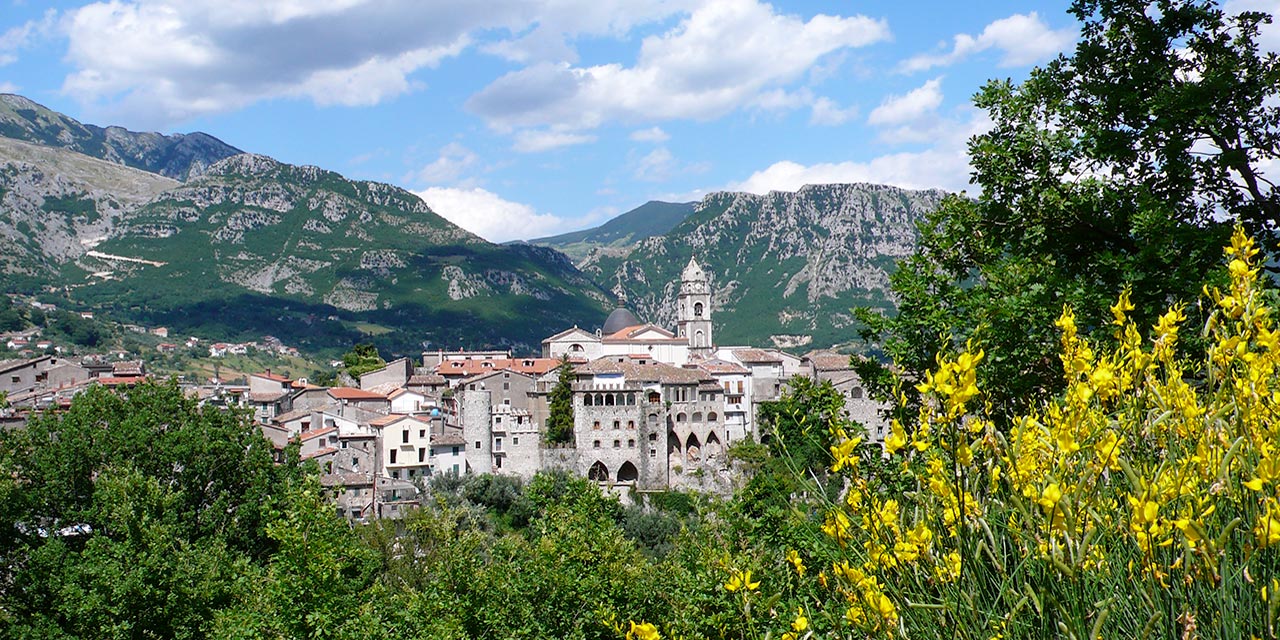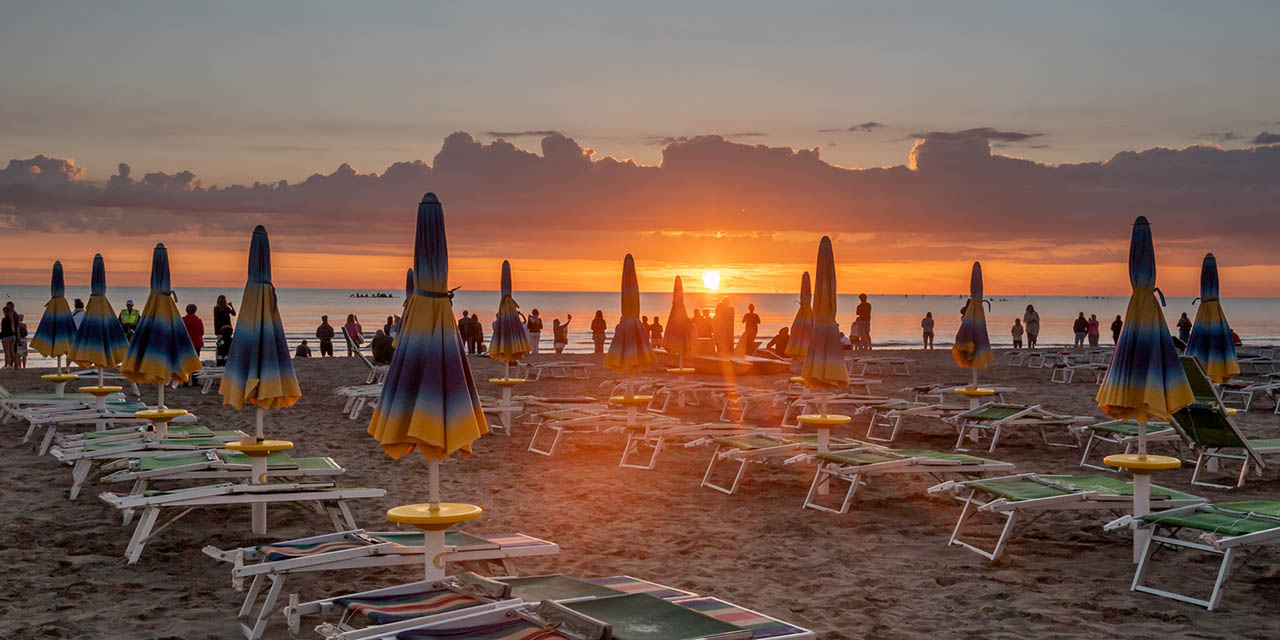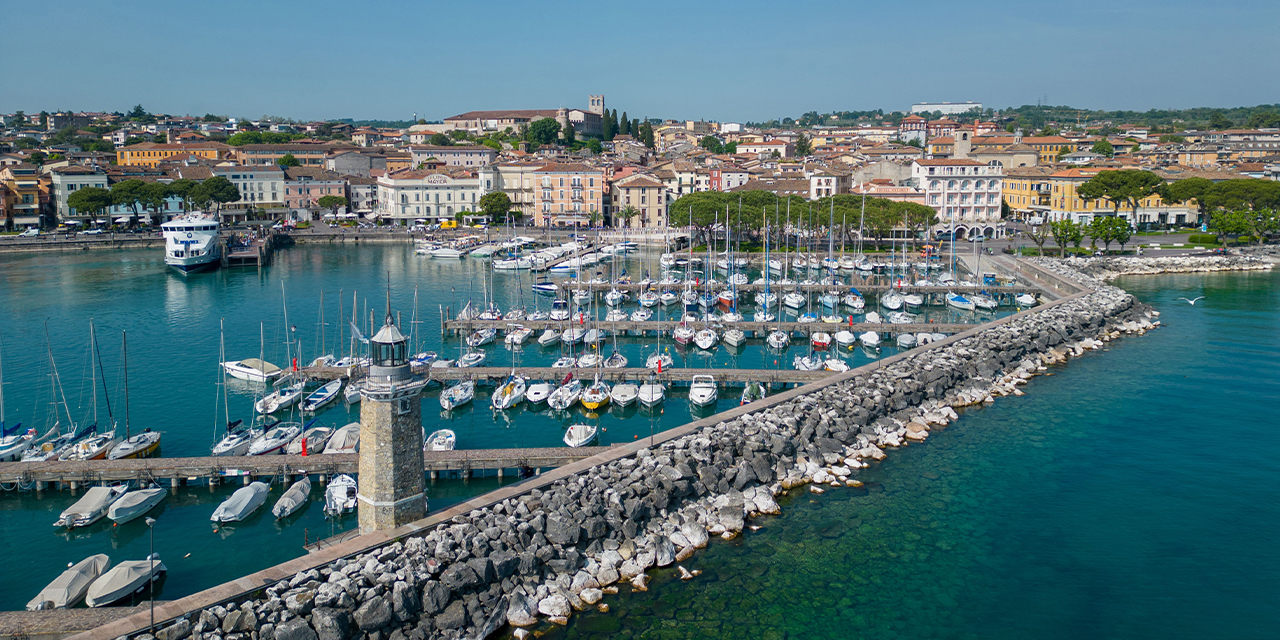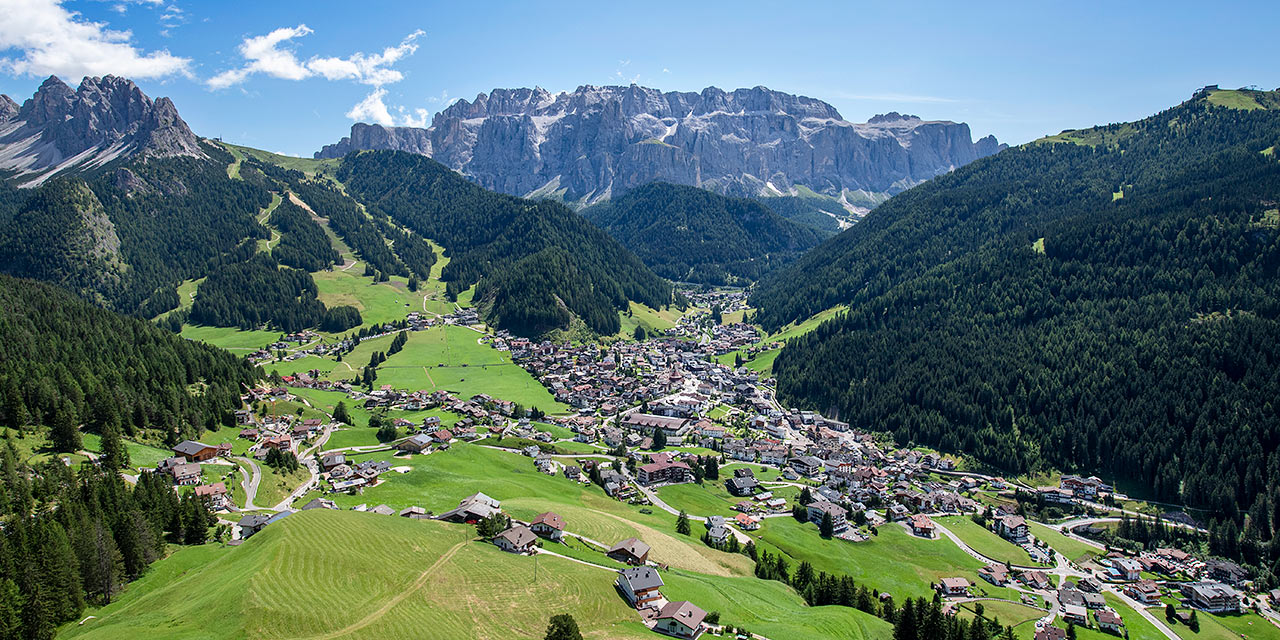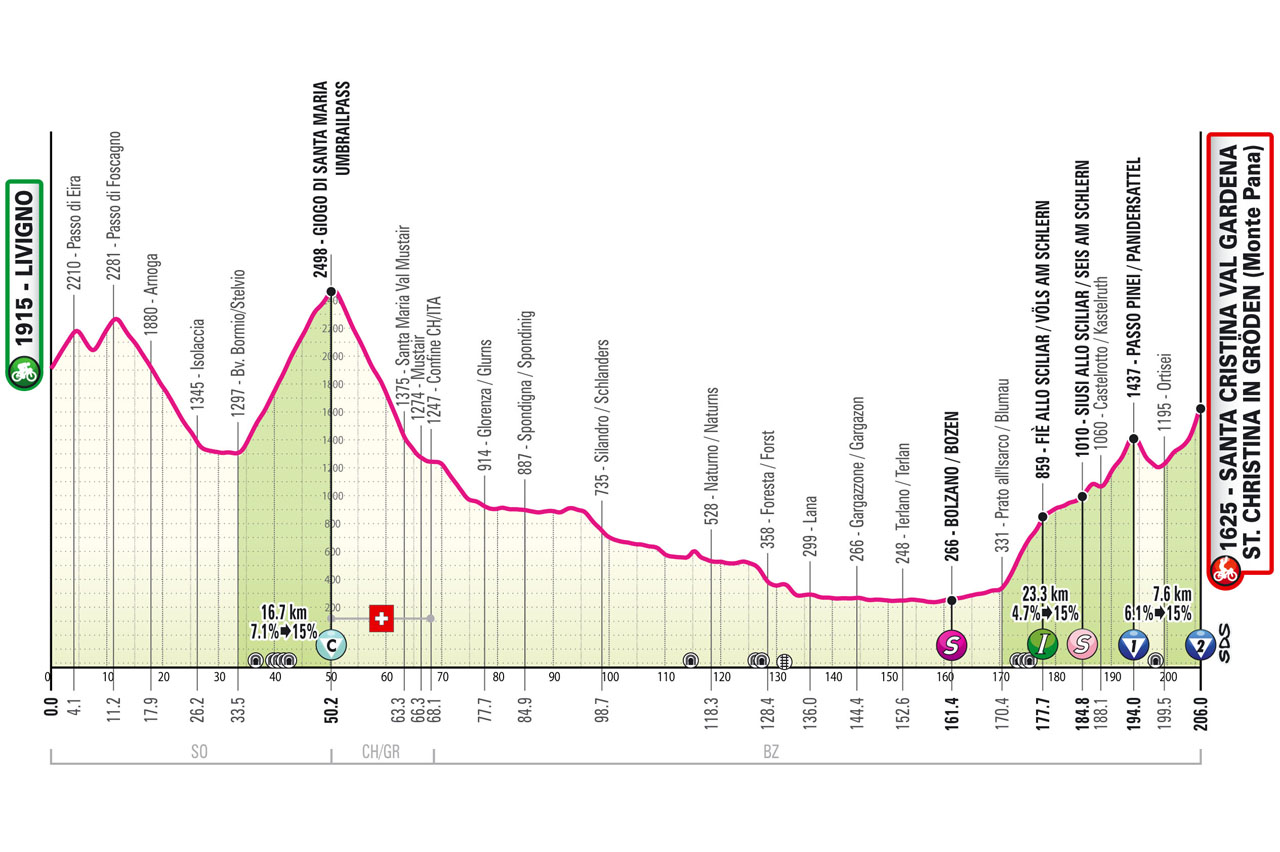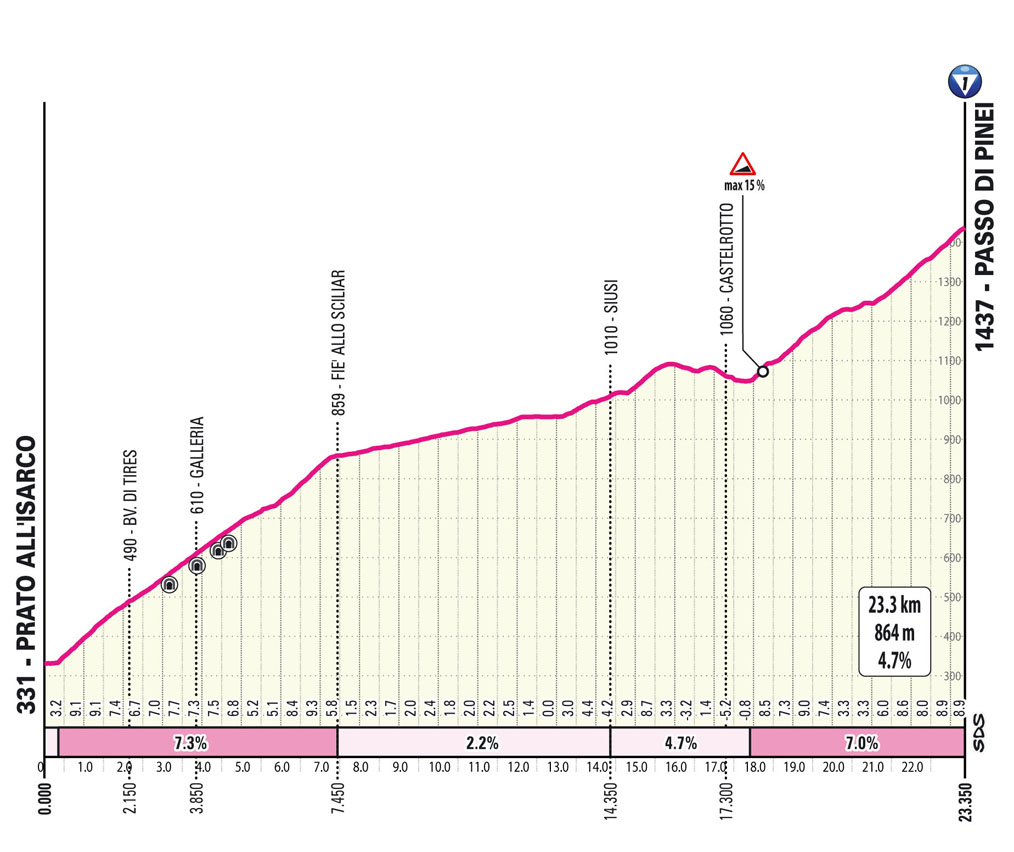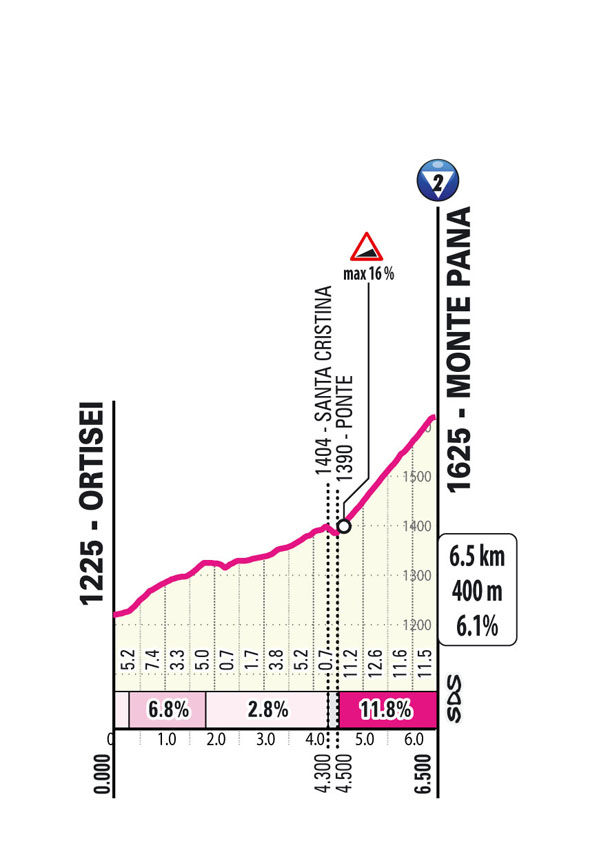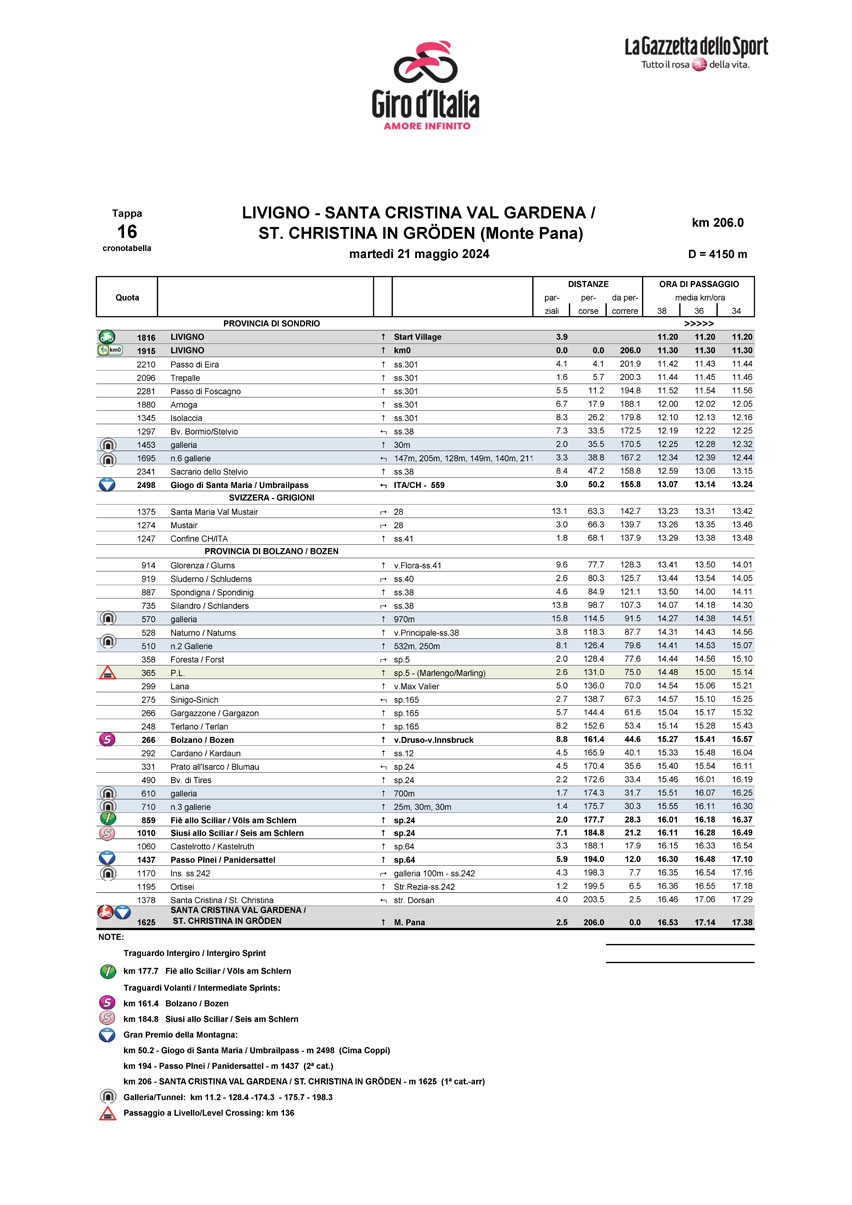
118.4 km - Altitude Gain 4,350m
Stage 16
Livigno -
Santa Cristina Val Gardena/St. Christina in Gröden
Tuesday 21 May 2024 118.4km Altitude Gain 4,350m
Total time: 2:49:37 Withdrawn: 4
Array( [0] => Array ( [type] => athletes [pos] => 1 [id] => 191 [name] => POGACAR Tadej [nome] => Tadej [cognome] => POGACAR [team] => UAE TEAM EMIRATES [sigla_team] => UAD [val] => 2:49:37 [distacco] => 0:00 [idx] => [localita] => [abbuono] => 0:10 ) [1] => Array ( [type] => athletes [pos] => 2 [id] => 205 [name] => PELLIZZARI Giulio [nome] => Giulio [cognome] => PELLIZZARI [team] => VF GROUP - BARDIANI CSF- FAIZANE' [sigla_team] => VBF [val] => 2:49:53 [distacco] => 0:16 [idx] => [localita] => [abbuono] => 0:06 ) [2] => Array ( [type] => athletes [pos] => 3 [id] => 41 [name] => MARTINEZ Daniel Felipe [nome] => Daniel Felipe [cognome] => MARTINEZ [team] => BORA - HANSGROHE [sigla_team] => BOH [val] => 2:49:53 [distacco] => 0:16 [idx] => [localita] => [abbuono] => 0:04 ) [3] => Array ( [type] => athletes [pos] => 4 [id] => 37 [name] => SCARONI Christian [nome] => Christian [cognome] => SCARONI [team] => ASTANA QAZAQSTAN TEAM [sigla_team] => AST [val] => 2:50:08 [distacco] => 0:31 [idx] => [localita] => [abbuono] => ) [4] => Array ( [type] => athletes [pos] => 5 [id] => 211 [name] => TIBERI Antonio [nome] => Antonio [cognome] => TIBERI [team] => BAHRAIN VICTORIOUS [sigla_team] => TBV [val] => 2:50:10 [distacco] => 0:33 [idx] => [localita] => [abbuono] => ) [5] => Array ( [type] => athletes [pos] => 6 [id] => 2 [name] => ARENSMAN Thymen [nome] => Thymen [cognome] => ARENSMAN [team] => INEOS GRENADIERS [sigla_team] => IGD [val] => 2:50:15 [distacco] => 0:38 [idx] => [localita] => [abbuono] => ) [6] => Array ( [type] => athletes [pos] => 7 [id] => 214 [name] => CARUSO Damiano [nome] => Damiano [cognome] => CARUSO [team] => BAHRAIN VICTORIOUS [sigla_team] => TBV [val] => 2:50:16 [distacco] => 0:39 [idx] => [localita] => [abbuono] => ) [7] => Array ( [type] => athletes [pos] => 8 [id] => 187 [name] => STORER Michael [nome] => Michael [cognome] => STORER [team] => TUDOR PRO CYCLING TEAM [sigla_team] => TUD [val] => 2:50:19 [distacco] => 0:42 [idx] => [localita] => [abbuono] => ) [8] => Array ( [type] => athletes [pos] => 9 [id] => 23 [name] => COSTIOU Ewen [nome] => Ewen [cognome] => COSTIOU [team] => ARKEA - B&B HOTELS [sigla_team] => ARK [val] => 2:50:19 [distacco] => 0:42 [idx] => [localita] => [abbuono] => ) [9] => Array ( [type] => athletes [pos] => 10 [id] => 64 [name] => PARET PEINTRE Valentin [nome] => Valentin [cognome] => PARET PEINTRE [team] => DECATHLON AG2R LA MONDIALE TEAM [sigla_team] => DAT [val] => 2:50:22 [distacco] => 0:45 [idx] => [localita] => [abbuono] => ) [10] => Array ( [type] => athletes [pos] => 11 [id] => 126 [name] => RUBIO Einer [nome] => Einer [cognome] => RUBIO [team] => MOVISTAR TEAM [sigla_team] => MOV [val] => 2:50:23 [distacco] => 0:46 [idx] => [localita] => [abbuono] => ) [11] => Array ( [type] => athletes [pos] => 12 [id] => 133 [name] => HIRT Jan [nome] => Jan [cognome] => HIRT [team] => SOUDAL QUICK - STEP [sigla_team] => SOQ [val] => 2:50:23 [distacco] => 0:46 [idx] => [localita] => [abbuono] => ) [12] => Array ( [type] => athletes [pos] => 13 [id] => 63 [name] => PARET PEINTRE Aurelien [nome] => Aurelien [cognome] => PARET PEINTRE [team] => DECATHLON AG2R LA MONDIALE TEAM [sigla_team] => DAT [val] => 2:50:26 [distacco] => 0:49 [idx] => [localita] => [abbuono] => ) [13] => Array ( [type] => athletes [pos] => 14 [id] => 61 [name] => O'CONNOR Ben [nome] => Ben [cognome] => O'CONNOR [team] => DECATHLON AG2R LA MONDIALE TEAM [sigla_team] => DAT [val] => 2:50:26 [distacco] => 0:49 [idx] => [localita] => [abbuono] => ) [14] => Array ( [type] => athletes [pos] => 15 [id] => 1 [name] => THOMAS Geraint [nome] => Geraint [cognome] => THOMAS [team] => INEOS GRENADIERS [sigla_team] => IGD [val] => 2:50:26 [distacco] => 0:49 [idx] => [localita] => [abbuono] => ) [15] => Array ( [type] => athletes [pos] => 16 [id] => 33 [name] => FORTUNATO Lorenzo [nome] => Lorenzo [cognome] => FORTUNATO [team] => ASTANA QAZAQSTAN TEAM [sigla_team] => AST [val] => 2:50:46 [distacco] => 01:09 [idx] => [localita] => [abbuono] => ) [16] => Array ( [type] => athletes [pos] => 17 [id] => 13 [name] => CONCI Nicola [nome] => Nicola [cognome] => CONCI [team] => ALPECIN - DECEUNINCK [sigla_team] => ADC [val] => 2:50:49 [distacco] => 01:12 [idx] => [localita] => [abbuono] => ) [17] => Array ( [type] => athletes [pos] => 18 [id] => 168 [name] => PIGANZOLI Davide [nome] => Davide [cognome] => PIGANZOLI [team] => TEAM POLTI KOMETA [sigla_team] => PTK [val] => 2:50:53 [distacco] => 01:16 [idx] => [localita] => [abbuono] => ) [18] => Array ( [type] => athletes [pos] => 19 [id] => 141 [name] => BARDET Romain [nome] => Romain [cognome] => BARDET [team] => TEAM DSM - FIRMENICH POSTNL [sigla_team] => DFP [val] => 2:50:56 [distacco] => 01:19 [idx] => [localita] => [abbuono] => ) [19] => Array ( [type] => athletes [pos] => 20 [id] => 158 [name] => ZANA Filippo [nome] => Filippo [cognome] => ZANA [team] => TEAM JAYCO ALULA [sigla_team] => JAY [val] => 2:50:59 [distacco] => 01:22 [idx] => [localita] => [abbuono] => ) [20] => Array ( [type] => athletes [pos] => 21 [id] => 177 [name] => VALTER Attila [nome] => Attila [cognome] => VALTER [team] => TEAM VISMA - LEASE A BIKE [sigla_team] => TVL [val] => 2:51:09 [distacco] => 01:32 [idx] => [localita] => [abbuono] => ) [21] => Array ( [type] => athletes [pos] => 22 [id] => 138 [name] => VANSEVENANT Mauri [nome] => Mauri [cognome] => VANSEVENANT [team] => SOUDAL QUICK - STEP [sigla_team] => SOQ [val] => 2:51:25 [distacco] => 01:48 [idx] => [localita] => [abbuono] => ) [22] => Array ( [type] => athletes [pos] => 23 [id] => 202 [name] => COVILI Luca [nome] => Luca [cognome] => COVILI [team] => VF GROUP - BARDIANI CSF- FAIZANE' [sigla_team] => VBF [val] => 2:51:27 [distacco] => 01:50 [idx] => [localita] => [abbuono] => ) [23] => Array ( [type] => athletes [pos] => 24 [id] => 196 [name] => MAJKA Rafal [nome] => Rafal [cognome] => MAJKA [team] => UAE TEAM EMIRATES [sigla_team] => UAD [val] => 2:51:38 [distacco] => 02:01 [idx] => [localita] => [abbuono] => ) [24] => Array ( [type] => athletes [pos] => 25 [id] => 62 [name] => BAUDIN Alex [nome] => Alex [cognome] => BAUDIN [team] => DECATHLON AG2R LA MONDIALE TEAM [sigla_team] => DAT [val] => 2:51:49 [distacco] => 02:12 [idx] => [localita] => [abbuono] => ) [25] => Array ( [type] => athletes [pos] => 26 [id] => 56 [name] => GESCHKE Simon [nome] => Simon [cognome] => GESCHKE [team] => COFIDIS [sigla_team] => COF [val] => 2:51:49 [distacco] => 02:12 [idx] => [localita] => [abbuono] => ) [26] => Array ( [type] => athletes [pos] => 27 [id] => 145 [name] => LEEMREIZE Gijs [nome] => Gijs [cognome] => LEEMREIZE [team] => TEAM DSM - FIRMENICH POSTNL [sigla_team] => DFP [val] => 2:52:23 [distacco] => 02:46 [idx] => [localita] => [abbuono] => ) [27] => Array ( [type] => athletes [pos] => 28 [id] => 201 [name] => POZZOVIVO Domenico [nome] => Domenico [cognome] => POZZOVIVO [team] => VF GROUP - BARDIANI CSF- FAIZANE' [sigla_team] => VBF [val] => 2:52:31 [distacco] => 02:54 [idx] => [localita] => [abbuono] => ) [28] => Array ( [type] => athletes [pos] => 29 [id] => 131 [name] => ALAPHILIPPE Julian [nome] => Julian [cognome] => ALAPHILIPPE [team] => SOUDAL QUICK - STEP [sigla_team] => SOQ [val] => 2:53:33 [distacco] => 03:56 [idx] => [localita] => [abbuono] => 0:06 ) [29] => Array ( [type] => athletes [pos] => 30 [id] => 147 [name] => VERMAERKE Kevin [nome] => Kevin [cognome] => VERMAERKE [team] => TEAM DSM - FIRMENICH POSTNL [sigla_team] => DFP [val] => 2:53:44 [distacco] => 04:07 [idx] => [localita] => [abbuono] => ) [30] => Array ( [type] => athletes [pos] => 31 [id] => 127 [name] => SANCHEZ Pelayo [nome] => Pelayo [cognome] => SANCHEZ [team] => MOVISTAR TEAM [sigla_team] => MOV [val] => 2:54:08 [distacco] => 04:31 [idx] => [localita] => [abbuono] => ) [31] => Array ( [type] => athletes [pos] => 32 [id] => 26 [name] => RIES Michel [nome] => Michel [cognome] => RIES [team] => ARKEA - B&B HOTELS [sigla_team] => ARK [val] => 2:54:51 [distacco] => 05:14 [idx] => [localita] => [abbuono] => ) [32] => Array ( [type] => athletes [pos] => 33 [id] => 53 [name] => CHAMPION Thomas [nome] => Thomas [cognome] => CHAMPION [team] => COFIDIS [sigla_team] => COF [val] => 2:55:34 [distacco] => 05:57 [idx] => [localita] => [abbuono] => ) [33] => Array ( [type] => athletes [pos] => 34 [id] => 88 [name] => PALENI Enzo [nome] => Enzo [cognome] => PALENI [team] => GROUPAMA - FDJ [sigla_team] => GFC [val] => 2:55:46 [distacco] => 06:09 [idx] => [localita] => [abbuono] => ) [34] => Array ( [type] => athletes [pos] => 35 [id] => 207 [name] => TONELLI Alessandro [nome] => Alessandro [cognome] => TONELLI [team] => VF GROUP - BARDIANI CSF- FAIZANE' [sigla_team] => VBF [val] => 2:55:53 [distacco] => 06:16 [idx] => [localita] => [abbuono] => ) [35] => Array ( [type] => athletes [pos] => 36 [id] => 175 [name] => TRATNIK Jan [nome] => Jan [cognome] => TRATNIK [team] => TEAM VISMA - LEASE A BIKE [sigla_team] => TVL [val] => 2:56:01 [distacco] => 06:24 [idx] => [localita] => [abbuono] => ) [36] => Array ( [type] => athletes [pos] => 37 [id] => 216 [name] => ZAMBANINI Edoardo [nome] => Edoardo [cognome] => ZAMBANINI [team] => BAHRAIN VICTORIOUS [sigla_team] => TBV [val] => 2:56:01 [distacco] => 06:24 [idx] => [localita] => [abbuono] => ) [37] => Array ( [type] => athletes [pos] => 38 [id] => 72 [name] => CEPEDA Jefferson [nome] => Jefferson [cognome] => CEPEDA [team] => EF EDUCATION - EASYPOST [sigla_team] => EFE [val] => 2:56:01 [distacco] => 06:24 [idx] => [localita] => [abbuono] => ) [38] => Array ( [type] => athletes [pos] => 39 [id] => 35 [name] => MULUEBERHAN Henok [nome] => Henok [cognome] => MULUEBERHAN [team] => ASTANA QAZAQSTAN TEAM [sigla_team] => AST [val] => 2:56:03 [distacco] => 06:26 [idx] => [localita] => [abbuono] => ) [39] => Array ( [type] => athletes [pos] => 40 [id] => 42 [name] => ALEOTTI Giovanni [nome] => Giovanni [cognome] => ALEOTTI [team] => BORA - HANSGROHE [sigla_team] => BOH [val] => 2:56:36 [distacco] => 06:59 [idx] => [localita] => [abbuono] => ) [40] => Array ( [type] => athletes [pos] => 41 [id] => 143 [name] => HAMILTON Christopher [nome] => Christopher [cognome] => HAMILTON [team] => TEAM DSM - FIRMENICH POSTNL [sigla_team] => DFP [val] => 2:56:36 [distacco] => 06:59 [idx] => [localita] => [abbuono] => ) [41] => Array ( [type] => athletes [pos] => 42 [id] => 198 [name] => NOVAK Domen [nome] => Domen [cognome] => NOVAK [team] => UAE TEAM EMIRATES [sigla_team] => UAD [val] => 2:57:12 [distacco] => 07:35 [idx] => [localita] => [abbuono] => ) [42] => Array ( [type] => athletes [pos] => 43 [id] => 121 [name] => QUINTANA Nairo [nome] => Nairo [cognome] => QUINTANA [team] => MOVISTAR TEAM [sigla_team] => MOV [val] => 2:57:18 [distacco] => 07:41 [idx] => [localita] => [abbuono] => ) [43] => Array ( [type] => athletes [pos] => 44 [id] => 75 [name] => HONORE' Frolich Mikkel [nome] => Frolich Mikkel [cognome] => HONORE' [team] => EF EDUCATION - EASYPOST [sigla_team] => EFE [val] => 2:58:31 [distacco] => 08:54 [idx] => [localita] => [abbuono] => ) [44] => Array ( [type] => athletes [pos] => 45 [id] => 67 [name] => VENDRAME Andrea [nome] => Andrea [cognome] => VENDRAME [team] => DECATHLON AG2R LA MONDIALE TEAM [sigla_team] => DAT [val] => 3:01:14 [distacco] => 11:37 [idx] => [localita] => [abbuono] => ) [45] => Array ( [type] => athletes [pos] => 46 [id] => 55 [name] => FERNANDEZ Ruben [nome] => Ruben [cognome] => FERNANDEZ [team] => COFIDIS [sigla_team] => COF [val] => 3:01:34 [distacco] => 11:57 [idx] => [localita] => [abbuono] => ) [46] => Array ( [type] => athletes [pos] => 47 [id] => 5 [name] => NARVAEZ Jhonatan [nome] => Jhonatan [cognome] => NARVAEZ [team] => INEOS GRENADIERS [sigla_team] => IGD [val] => 3:01:34 [distacco] => 11:57 [idx] => [localita] => [abbuono] => ) [47] => Array ( [type] => athletes [pos] => 48 [id] => 47 [name] => SCHACHMANN Maximilian [nome] => Maximilian [cognome] => SCHACHMANN [team] => BORA - HANSGROHE [sigla_team] => BOH [val] => 3:02:44 [distacco] => 13:07 [idx] => [localita] => [abbuono] => ) [48] => Array ( [type] => athletes [pos] => 49 [id] => 92 [name] => CALMEJANE Lilian [nome] => Lilian [cognome] => CALMEJANE [team] => INTERMARCHE' - WANTY [sigla_team] => IWA [val] => 3:03:48 [distacco] => 14:11 [idx] => [localita] => [abbuono] => ) [49] => Array ( [type] => athletes [pos] => 50 [id] => 103 [name] => FRIGO Marco [nome] => Marco [cognome] => FRIGO [team] => ISRAEL - PREMIER TECH [sigla_team] => IPT [val] => 3:04:26 [distacco] => 14:49 [idx] => [localita] => [abbuono] => ) [50] => Array ( [type] => athletes [pos] => 51 [id] => 151 [name] => DE MARCHI Alessandro [nome] => Alessandro [cognome] => DE MARCHI [team] => TEAM JAYCO ALULA [sigla_team] => JAY [val] => 3:04:26 [distacco] => 14:49 [idx] => [localita] => [abbuono] => ) [51] => Array ( [type] => athletes [pos] => 52 [id] => 136 [name] => SERRY Pieter [nome] => Pieter [cognome] => SERRY [team] => SOUDAL QUICK - STEP [sigla_team] => SOQ [val] => 3:04:26 [distacco] => 14:49 [idx] => [localita] => [abbuono] => ) [52] => Array ( [type] => athletes [pos] => 53 [id] => 7 [name] => SWIFT Ben [nome] => Ben [cognome] => SWIFT [team] => INEOS GRENADIERS [sigla_team] => IGD [val] => 3:04:26 [distacco] => 14:49 [idx] => [localita] => [abbuono] => ) [53] => Array ( [type] => athletes [pos] => 54 [id] => 165 [name] => MAESTRI Mirco [nome] => Mirco [cognome] => MAESTRI [team] => TEAM POLTI KOMETA [sigla_team] => PTK [val] => 3:04:42 [distacco] => 15:05 [idx] => [localita] => [abbuono] => ) [54] => Array ( [type] => athletes [pos] => 55 [id] => 167 [name] => PIETROBON Andrea [nome] => Andrea [cognome] => PIETROBON [team] => TEAM POLTI KOMETA [sigla_team] => PTK [val] => 3:04:42 [distacco] => 15:05 [idx] => [localita] => [abbuono] => 0:02 ) [55] => Array ( [type] => athletes [pos] => 56 [id] => 3 [name] => FOSS Tobias [nome] => Tobias [cognome] => FOSS [team] => INEOS GRENADIERS [sigla_team] => IGD [val] => 3:05:04 [distacco] => 15:27 [idx] => [localita] => [abbuono] => ) [56] => Array ( [type] => athletes [pos] => 57 [id] => 32 [name] => BALLERINI Davide [nome] => Davide [cognome] => BALLERINI [team] => ASTANA QAZAQSTAN TEAM [sigla_team] => AST [val] => 3:06:04 [distacco] => 16:27 [idx] => [localita] => [abbuono] => 0:03 ) [57] => Array ( [type] => athletes [pos] => 58 [id] => 8 [name] => SWIFT Connor [nome] => Connor [cognome] => SWIFT [team] => INEOS GRENADIERS [sigla_team] => IGD [val] => 3:06:10 [distacco] => 16:33 [idx] => [localita] => [abbuono] => ) [58] => Array ( [type] => athletes [pos] => 59 [id] => 194 [name] => GROSSSCHARTNER Felix [nome] => Felix [cognome] => GROSSSCHARTNER [team] => UAE TEAM EMIRATES [sigla_team] => UAD [val] => 3:07:37 [distacco] => 18:00 [idx] => [localita] => [abbuono] => ) [59] => Array ( [type] => athletes [pos] => 60 [id] => 125 [name] => MILESI Lorenzo [nome] => Lorenzo [cognome] => MILESI [team] => MOVISTAR TEAM [sigla_team] => MOV [val] => 3:09:08 [distacco] => 19:31 [idx] => [localita] => [abbuono] => ) [60] => Array ( [type] => athletes [pos] => 61 [id] => 128 [name] => TORRES Albert [nome] => Albert [cognome] => TORRES [team] => MOVISTAR TEAM [sigla_team] => MOV [val] => 3:09:26 [distacco] => 19:49 [idx] => [localita] => [abbuono] => ) [61] => Array ( [type] => athletes [pos] => 62 [id] => 43 [name] => GAMPER Patrick [nome] => Patrick [cognome] => GAMPER [team] => BORA - HANSGROHE [sigla_team] => BOH [val] => 3:09:26 [distacco] => 19:49 [idx] => [localita] => [abbuono] => ) [62] => Array ( [type] => athletes [pos] => 63 [id] => 102 [name] => CLARKE Simon [nome] => Simon [cognome] => CLARKE [team] => ISRAEL - PREMIER TECH [sigla_team] => IPT [val] => 3:09:26 [distacco] => 19:49 [idx] => [localita] => [abbuono] => ) [63] => Array ( [type] => athletes [pos] => 64 [id] => 161 [name] => FABBRO Matteo [nome] => Matteo [cognome] => FABBRO [team] => TEAM POLTI KOMETA [sigla_team] => PTK [val] => 3:09:26 [distacco] => 19:49 [idx] => [localita] => [abbuono] => ) [64] => Array ( [type] => athletes [pos] => 65 [id] => 93 [name] => COLLEONI Kevin [nome] => Kevin [cognome] => COLLEONI [team] => INTERMARCHE' - WANTY [sigla_team] => IWA [val] => 3:09:26 [distacco] => 19:49 [idx] => [localita] => [abbuono] => ) [65] => Array ( [type] => athletes [pos] => 66 [id] => 81 [name] => PITHIE Laurence [nome] => Laurence [cognome] => PITHIE [team] => GROUPAMA - FDJ [sigla_team] => GFC [val] => 3:09:26 [distacco] => 19:49 [idx] => [localita] => [abbuono] => ) [66] => Array ( [type] => athletes [pos] => 67 [id] => 83 [name] => BARTHE Cyril [nome] => Cyril [cognome] => BARTHE [team] => GROUPAMA - FDJ [sigla_team] => GFC [val] => 3:09:26 [distacco] => 19:49 [idx] => [localita] => [abbuono] => ) [67] => Array ( [type] => athletes [pos] => 68 [id] => 58 [name] => WOOD Harrison [nome] => Harrison [cognome] => WOOD [team] => COFIDIS [sigla_team] => COF [val] => 3:09:26 [distacco] => 19:49 [idx] => [localita] => [abbuono] => ) [68] => Array ( [type] => athletes [pos] => 69 [id] => 73 [name] => DE BOD Stefan [nome] => Stefan [cognome] => DE BOD [team] => EF EDUCATION - EASYPOST [sigla_team] => EFE [val] => 3:09:26 [distacco] => 19:49 [idx] => [localita] => [abbuono] => ) [69] => Array ( [type] => athletes [pos] => 70 [id] => 95 [name] => MIHKELS Madis [nome] => Madis [cognome] => MIHKELS [team] => INTERMARCHE' - WANTY [sigla_team] => IWA [val] => 3:09:26 [distacco] => 19:49 [idx] => [localita] => [abbuono] => ) [70] => Array ( [type] => athletes [pos] => 71 [id] => 85 [name] => GERMANI Lorenzo [nome] => Lorenzo [cognome] => GERMANI [team] => GROUPAMA - FDJ [sigla_team] => GFC [val] => 3:09:26 [distacco] => 19:49 [idx] => [localita] => [abbuono] => ) [71] => Array ( [type] => athletes [pos] => 72 [id] => 162 [name] => BAIS Davide [nome] => Davide [cognome] => BAIS [team] => TEAM POLTI KOMETA [sigla_team] => PTK [val] => 3:09:26 [distacco] => 19:49 [idx] => [localita] => [abbuono] => ) [72] => Array ( [type] => athletes [pos] => 73 [id] => 38 [name] => VELASCO Simone [nome] => Simone [cognome] => VELASCO [team] => ASTANA QAZAQSTAN TEAM [sigla_team] => AST [val] => 3:09:26 [distacco] => 19:49 [idx] => [localita] => [abbuono] => ) [73] => Array ( [type] => athletes [pos] => 74 [id] => 28 [name] => VERRE Alessandro [nome] => Alessandro [cognome] => VERRE [team] => ARKEA - B&B HOTELS [sigla_team] => ARK [val] => 3:09:26 [distacco] => 19:49 [idx] => [localita] => [abbuono] => ) [74] => Array ( [type] => athletes [pos] => 75 [id] => 163 [name] => BAIS Mattia [nome] => Mattia [cognome] => BAIS [team] => TEAM POLTI KOMETA [sigla_team] => PTK [val] => 3:09:26 [distacco] => 19:49 [idx] => [localita] => [abbuono] => ) [75] => Array ( [type] => athletes [pos] => 76 [id] => 66 [name] => TRONCHON Bastien [nome] => Bastien [cognome] => TRONCHON [team] => DECATHLON AG2R LA MONDIALE TEAM [sigla_team] => DAT [val] => 3:09:26 [distacco] => 19:49 [idx] => [localita] => [abbuono] => ) [76] => Array ( [type] => athletes [pos] => 77 [id] => 122 [name] => BARTA William [nome] => William [cognome] => BARTA [team] => MOVISTAR TEAM [sigla_team] => MOV [val] => 3:09:26 [distacco] => 19:49 [idx] => [localita] => [abbuono] => ) [77] => Array ( [type] => athletes [pos] => 78 [id] => 181 [name] => TRENTIN Matteo [nome] => Matteo [cognome] => TRENTIN [team] => TUDOR PRO CYCLING TEAM [sigla_team] => TUD [val] => 3:09:26 [distacco] => 19:49 [idx] => [localita] => [abbuono] => ) [78] => Array ( [type] => athletes [pos] => 79 [id] => 114 [name] => GHEBREIGZABHIER Amanuel [nome] => Amanuel [cognome] => GHEBREIGZABHIER [team] => LIDL-TREK [sigla_team] => LTK [val] => 3:09:26 [distacco] => 19:49 [idx] => [localita] => [abbuono] => ) [79] => Array ( [type] => athletes [pos] => 80 [id] => 68 [name] => WARBASSE Lawrence [nome] => Lawrence [cognome] => WARBASSE [team] => DECATHLON AG2R LA MONDIALE TEAM [sigla_team] => DAT [val] => 3:09:26 [distacco] => 19:49 [idx] => [localita] => [abbuono] => ) [80] => Array ( [type] => athletes [pos] => 81 [id] => 65 [name] => TOUZE Damien [nome] => Damien [cognome] => TOUZE [team] => DECATHLON AG2R LA MONDIALE TEAM [sigla_team] => DAT [val] => 3:09:26 [distacco] => 19:49 [idx] => [localita] => [abbuono] => ) [81] => Array ( [type] => athletes [pos] => 82 [id] => 97 [name] => SMITH Dion [nome] => Dion [cognome] => SMITH [team] => INTERMARCHE' - WANTY [sigla_team] => IWA [val] => 3:09:26 [distacco] => 19:49 [idx] => [localita] => [abbuono] => ) [82] => Array ( [type] => athletes [pos] => 83 [id] => 212 [name] => KEPPLINGER Rainer [nome] => Rainer [cognome] => KEPPLINGER [team] => BAHRAIN VICTORIOUS [sigla_team] => TBV [val] => 3:09:26 [distacco] => 19:49 [idx] => [localita] => [abbuono] => ) [83] => Array ( [type] => athletes [pos] => 84 [id] => 206 [name] => TAROZZI Manuele [nome] => Manuele [cognome] => TAROZZI [team] => VF GROUP - BARDIANI CSF- FAIZANE' [sigla_team] => VBF [val] => 3:09:26 [distacco] => 19:49 [idx] => [localita] => [abbuono] => ) [84] => Array ( [type] => athletes [pos] => 85 [id] => 14 [name] => HERMANS Quinten [nome] => Quinten [cognome] => HERMANS [team] => ALPECIN - DECEUNINCK [sigla_team] => ADC [val] => 3:09:26 [distacco] => 19:49 [idx] => [localita] => [abbuono] => ) [85] => Array ( [type] => athletes [pos] => 86 [id] => 78 [name] => VALGREN Michael [nome] => Michael [cognome] => VALGREN [team] => EF EDUCATION - EASYPOST [sigla_team] => EFE [val] => 3:09:26 [distacco] => 19:49 [idx] => [localita] => [abbuono] => ) [86] => Array ( [type] => athletes [pos] => 87 [id] => 107 [name] => SCHULTZ Nicholas [nome] => Nicholas [cognome] => SCHULTZ [team] => ISRAEL - PREMIER TECH [sigla_team] => IPT [val] => 3:09:26 [distacco] => 19:49 [idx] => [localita] => [abbuono] => ) [87] => Array ( [type] => athletes [pos] => 88 [id] => 184 [name] => KAMP Alexander [nome] => Alexander [cognome] => KAMP [team] => TUDOR PRO CYCLING TEAM [sigla_team] => TUD [val] => 3:09:26 [distacco] => 19:49 [idx] => [localita] => [abbuono] => ) [88] => Array ( [type] => athletes [pos] => 89 [id] => 195 [name] => LAENGEN Vegard Stake [nome] => Vegard Stake [cognome] => LAENGEN [team] => UAE TEAM EMIRATES [sigla_team] => UAD [val] => 3:09:26 [distacco] => 19:49 [idx] => [localita] => [abbuono] => ) [89] => Array ( [type] => athletes [pos] => 90 [id] => 116 [name] => LOPEZ Juan Pedro [nome] => Juan Pedro [cognome] => LOPEZ [team] => LIDL-TREK [sigla_team] => LTK [val] => 3:09:26 [distacco] => 19:49 [idx] => [localita] => [abbuono] => ) [90] => Array ( [type] => athletes [pos] => 91 [id] => 15 [name] => JANSSENS Jimmy [nome] => Jimmy [cognome] => JANSSENS [team] => ALPECIN - DECEUNINCK [sigla_team] => ADC [val] => 3:09:26 [distacco] => 19:49 [idx] => [localita] => [abbuono] => ) [91] => Array ( [type] => athletes [pos] => 92 [id] => 134 [name] => LAMPERTI Luke [nome] => Luke [cognome] => LAMPERTI [team] => SOUDAL QUICK - STEP [sigla_team] => SOQ [val] => 3:09:26 [distacco] => 19:49 [idx] => [localita] => [abbuono] => ) [92] => Array ( [type] => athletes [pos] => 93 [id] => 18 [name] => VAN DEN BOSSCHE Fabio [nome] => Fabio [cognome] => VAN DEN BOSSCHE [team] => ALPECIN - DECEUNINCK [sigla_team] => ADC [val] => 3:09:26 [distacco] => 19:49 [idx] => [localita] => [abbuono] => ) [93] => Array ( [type] => athletes [pos] => 94 [id] => 76 [name] => PICCOLO Andrea [nome] => Andrea [cognome] => PICCOLO [team] => EF EDUCATION - EASYPOST [sigla_team] => EFE [val] => 3:10:31 [distacco] => 20:54 [idx] => [localita] => [abbuono] => ) [94] => Array ( [type] => athletes [pos] => 95 [id] => 204 [name] => MARCELLUSI Martin [nome] => Martin [cognome] => MARCELLUSI [team] => VF GROUP - BARDIANI CSF- FAIZANE' [sigla_team] => VBF [val] => 3:11:43 [distacco] => 22:06 [idx] => [localita] => [abbuono] => ) [95] => Array ( [type] => athletes [pos] => 96 [id] => 192 [name] => OLIVEIRA Rui [nome] => Rui [cognome] => OLIVEIRA [team] => UAE TEAM EMIRATES [sigla_team] => UAD [val] => 3:11:43 [distacco] => 22:06 [idx] => [localita] => [abbuono] => ) [96] => Array ( [type] => athletes [pos] => 97 [id] => 203 [name] => FIORELLI Filippo [nome] => Filippo [cognome] => FIORELLI [team] => VF GROUP - BARDIANI CSF- FAIZANE' [sigla_team] => VBF [val] => 3:13:18 [distacco] => 23:41 [idx] => [localita] => [abbuono] => 0:01 ) [97] => Array ( [type] => athletes [pos] => 98 [id] => 77 [name] => STEINHAUSER Georg [nome] => Georg [cognome] => STEINHAUSER [team] => EF EDUCATION - EASYPOST [sigla_team] => EFE [val] => 3:14:00 [distacco] => 24:23 [idx] => [localita] => [abbuono] => ) [98] => Array ( [type] => athletes [pos] => 99 [id] => 71 [name] => CHAVES Esteban [nome] => Esteban [cognome] => CHAVES [team] => EF EDUCATION - EASYPOST [sigla_team] => EFE [val] => 3:14:12 [distacco] => 24:35 [idx] => [localita] => [abbuono] => ) [99] => Array ( [type] => athletes [pos] => 100 [id] => 217 [name] => SUTTERLIN Jasha [nome] => Jasha [cognome] => SUTTERLIN [team] => BAHRAIN VICTORIOUS [sigla_team] => TBV [val] => 3:14:27 [distacco] => 24:50 [idx] => [localita] => [abbuono] => ) [100] => Array ( [type] => athletes [pos] => 101 [id] => 12 [name] => BAYER Tobias [nome] => Tobias [cognome] => BAYER [team] => ALPECIN - DECEUNINCK [sigla_team] => ADC [val] => 3:17:06 [distacco] => 27:29 [idx] => [localita] => [abbuono] => ) [101] => Array ( [type] => athletes [pos] => 102 [id] => 27 [name] => RIOU Alan [nome] => Alan [cognome] => RIOU [team] => ARKEA - B&B HOTELS [sigla_team] => ARK [val] => 3:17:06 [distacco] => 27:29 [idx] => [localita] => [abbuono] => ) [102] => Array ( [type] => athletes [pos] => 103 [id] => 111 [name] => MILAN Jonathan [nome] => Jonathan [cognome] => MILAN [team] => LIDL-TREK [sigla_team] => LTK [val] => 3:17:08 [distacco] => 27:31 [idx] => [localita] => [abbuono] => ) [103] => Array ( [type] => athletes [pos] => 104 [id] => 113 [name] => CONSONNI Simone [nome] => Simone [cognome] => CONSONNI [team] => LIDL-TREK [sigla_team] => LTK [val] => 3:17:08 [distacco] => 27:31 [idx] => [localita] => [abbuono] => ) [104] => Array ( [type] => athletes [pos] => 105 [id] => 215 [name] => PASQUALON Andrea [nome] => Andrea [cognome] => PASQUALON [team] => BAHRAIN VICTORIOUS [sigla_team] => TBV [val] => 3:17:08 [distacco] => 27:31 [idx] => [localita] => [abbuono] => ) [105] => Array ( [type] => athletes [pos] => 106 [id] => 6 [name] => SHEFFIELD Magnus [nome] => Magnus [cognome] => SHEFFIELD [team] => INEOS GRENADIERS [sigla_team] => IGD [val] => 3:17:08 [distacco] => 27:31 [idx] => [localita] => [abbuono] => ) [106] => Array ( [type] => athletes [pos] => 107 [id] => 94 [name] => DE POOTER Dries [nome] => Dries [cognome] => DE POOTER [team] => INTERMARCHE' - WANTY [sigla_team] => IWA [val] => 3:17:08 [distacco] => 27:31 [idx] => [localita] => [abbuono] => ) [107] => Array ( [type] => athletes [pos] => 108 [id] => 166 [name] => MUNOZ Francisco [nome] => Francisco [cognome] => MUNOZ [team] => TEAM POLTI KOMETA [sigla_team] => PTK [val] => 3:17:08 [distacco] => 27:31 [idx] => [localita] => [abbuono] => ) [108] => Array ( [type] => athletes [pos] => 109 [id] => 4 [name] => GANNA Filippo [nome] => Filippo [cognome] => GANNA [team] => INEOS GRENADIERS [sigla_team] => IGD [val] => 3:17:08 [distacco] => 27:31 [idx] => [localita] => [abbuono] => ) [109] => Array ( [type] => athletes [pos] => 110 [id] => 208 [name] => ZANONCELLO Enrico [nome] => Enrico [cognome] => ZANONCELLO [team] => VF GROUP - BARDIANI CSF- FAIZANE' [sigla_team] => VBF [val] => 3:17:08 [distacco] => 27:31 [idx] => [localita] => [abbuono] => ) [110] => Array ( [type] => athletes [pos] => 111 [id] => 112 [name] => BAGIOLI Andrea [nome] => Andrea [cognome] => BAGIOLI [team] => LIDL-TREK [sigla_team] => LTK [val] => 3:17:08 [distacco] => 27:31 [idx] => [localita] => [abbuono] => ) [111] => Array ( [type] => athletes [pos] => 112 [id] => 188 [name] => STORK Florian [nome] => Florian [cognome] => STORK [team] => TUDOR PRO CYCLING TEAM [sigla_team] => TUD [val] => 3:17:08 [distacco] => 27:31 [idx] => [localita] => [abbuono] => ) [112] => Array ( [type] => athletes [pos] => 113 [id] => 154 [name] => HEPBURN Michael [nome] => Michael [cognome] => HEPBURN [team] => TEAM JAYCO ALULA [sigla_team] => JAY [val] => 3:17:08 [distacco] => 27:31 [idx] => [localita] => [abbuono] => ) [113] => Array ( [type] => athletes [pos] => 114 [id] => 124 [name] => GAVIRIA Fernando [nome] => Fernando [cognome] => GAVIRIA [team] => MOVISTAR TEAM [sigla_team] => MOV [val] => 3:17:08 [distacco] => 27:31 [idx] => [localita] => [abbuono] => ) [114] => Array ( [type] => athletes [pos] => 115 [id] => 156 [name] => PLAPP Lucas [nome] => Lucas [cognome] => PLAPP [team] => TEAM JAYCO ALULA [sigla_team] => JAY [val] => 3:17:08 [distacco] => 27:31 [idx] => [localita] => [abbuono] => ) [115] => Array ( [type] => athletes [pos] => 116 [id] => 164 [name] => LONARDI Giovanni [nome] => Giovanni [cognome] => LONARDI [team] => TEAM POLTI KOMETA [sigla_team] => PTK [val] => 3:17:08 [distacco] => 27:31 [idx] => [localita] => [abbuono] => ) [116] => Array ( [type] => athletes [pos] => 117 [id] => 25 [name] => GRONDIN Donavan [nome] => Donavan [cognome] => GRONDIN [team] => ARKEA - B&B HOTELS [sigla_team] => ARK [val] => 3:17:08 [distacco] => 27:31 [idx] => [localita] => [abbuono] => ) [117] => Array ( [type] => athletes [pos] => 118 [id] => 54 [name] => DEBEAUMARCHE Nicolas [nome] => Nicolas [cognome] => DEBEAUMARCHE [team] => COFIDIS [sigla_team] => COF [val] => 3:17:08 [distacco] => 27:31 [idx] => [localita] => [abbuono] => ) [118] => Array ( [type] => athletes [pos] => 119 [id] => 182 [name] => DAINESE Alberto [nome] => Alberto [cognome] => DAINESE [team] => TUDOR PRO CYCLING TEAM [sigla_team] => TUD [val] => 3:17:08 [distacco] => 27:31 [idx] => [localita] => [abbuono] => ) [119] => Array ( [type] => athletes [pos] => 120 [id] => 87 [name] => LIENHARD Fabian [nome] => Fabian [cognome] => LIENHARD [team] => GROUPAMA - FDJ [sigla_team] => GFC [val] => 3:17:08 [distacco] => 27:31 [idx] => [localita] => [abbuono] => ) [120] => Array ( [type] => athletes [pos] => 121 [id] => 98 [name] => VAN SINTMAARTENSDIJK Roel [nome] => Roel [cognome] => VAN SINTMAARTENSDIJK [team] => INTERMARCHE' - WANTY [sigla_team] => IWA [val] => 3:17:08 [distacco] => 27:31 [idx] => [localita] => [abbuono] => ) [121] => Array ( [type] => athletes [pos] => 122 [id] => 17 [name] => PLANCKAERT Edward [nome] => Edward [cognome] => PLANCKAERT [team] => ALPECIN - DECEUNINCK [sigla_team] => ADC [val] => 3:17:23 [distacco] => 27:46 [idx] => [localita] => [abbuono] => ) [122] => Array ( [type] => athletes [pos] => 123 [id] => 11 [name] => GROVES Kaden [nome] => Kaden [cognome] => GROVES [team] => ALPECIN - DECEUNINCK [sigla_team] => ADC [val] => 3:17:23 [distacco] => 27:46 [idx] => [localita] => [abbuono] => ) [123] => Array ( [type] => athletes [pos] => 124 [id] => 178 [name] => VAN DIJKE Tim [nome] => Tim [cognome] => VAN DIJKE [team] => TEAM VISMA - LEASE A BIKE [sigla_team] => TVL [val] => 3:17:30 [distacco] => 27:53 [idx] => [localita] => [abbuono] => ) [124] => Array ( [type] => athletes [pos] => 125 [id] => 137 [name] => VAN LERBERGHE Bert [nome] => Bert [cognome] => VAN LERBERGHE [team] => SOUDAL QUICK - STEP [sigla_team] => SOQ [val] => 3:17:30 [distacco] => 27:53 [idx] => [localita] => [abbuono] => ) [125] => Array ( [type] => athletes [pos] => 126 [id] => 16 [name] => KIELICH Timo [nome] => Timo [cognome] => KIELICH [team] => ALPECIN - DECEUNINCK [sigla_team] => ADC [val] => 3:17:30 [distacco] => 27:53 [idx] => [localita] => [abbuono] => ) [126] => Array ( [type] => athletes [pos] => 127 [id] => 123 [name] => CIMOLAI Davide [nome] => Davide [cognome] => CIMOLAI [team] => MOVISTAR TEAM [sigla_team] => MOV [val] => 3:17:30 [distacco] => 27:53 [idx] => [localita] => [abbuono] => ) [127] => Array ( [type] => athletes [pos] => 128 [id] => 157 [name] => WALSCHEID Maximilian [nome] => Maximilian [cognome] => WALSCHEID [team] => TEAM JAYCO ALULA [sigla_team] => JAY [val] => 3:17:30 [distacco] => 27:53 [idx] => [localita] => [abbuono] => ) [128] => Array ( [type] => athletes [pos] => 129 [id] => 115 [name] => HOOLE Daan [nome] => Daan [cognome] => HOOLE [team] => LIDL-TREK [sigla_team] => LTK [val] => 3:17:30 [distacco] => 27:53 [idx] => [localita] => [abbuono] => ) [129] => Array ( [type] => athletes [pos] => 130 [id] => 135 [name] => MERLIER Tim [nome] => Tim [cognome] => MERLIER [team] => SOUDAL QUICK - STEP [sigla_team] => SOQ [val] => 3:17:30 [distacco] => 27:53 [idx] => [localita] => [abbuono] => ) [130] => Array ( [type] => athletes [pos] => 131 [id] => 197 [name] => MOLANO Juan Sebastian [nome] => Juan Sebastian [cognome] => MOLANO [team] => UAE TEAM EMIRATES [sigla_team] => UAD [val] => 3:17:36 [distacco] => 27:59 [idx] => [localita] => [abbuono] => ) [131] => Array ( [type] => athletes [pos] => 132 [id] => 172 [name] => AFFINI Edoardo [nome] => Edoardo [cognome] => AFFINI [team] => TEAM VISMA - LEASE A BIKE [sigla_team] => TVL [val] => 3:17:41 [distacco] => 28:04 [idx] => [localita] => [abbuono] => ) [132] => Array ( [type] => athletes [pos] => 133 [id] => 117 [name] => STUYVEN Jasper [nome] => Jasper [cognome] => STUYVEN [team] => LIDL-TREK [sigla_team] => LTK [val] => 3:17:45 [distacco] => 28:08 [idx] => [localita] => [abbuono] => ) [133] => Array ( [type] => athletes [pos] => 134 [id] => 44 [name] => KOCH Jonas [nome] => Jonas [cognome] => KOCH [team] => BORA - HANSGROHE [sigla_team] => BOH [val] => 3:18:11 [distacco] => 28:34 [idx] => [localita] => [abbuono] => ) [134] => Array ( [type] => athletes [pos] => 135 [id] => 46 [name] => MULLEN Ryan [nome] => Ryan [cognome] => MULLEN [team] => BORA - HANSGROHE [sigla_team] => BOH [val] => 3:18:11 [distacco] => 28:34 [idx] => [localita] => [abbuono] => ) [135] => Array ( [type] => athletes [pos] => 136 [id] => 183 [name] => FROIDEVAUX Robin [nome] => Robin [cognome] => FROIDEVAUX [team] => TUDOR PRO CYCLING TEAM [sigla_team] => TUD [val] => 3:18:17 [distacco] => 28:40 [idx] => [localita] => [abbuono] => ) [136] => Array ( [type] => athletes [pos] => 137 [id] => 82 [name] => ASKEY Lewis [nome] => Lewis [cognome] => ASKEY [team] => GROUPAMA - FDJ [sigla_team] => GFC [val] => 3:18:17 [distacco] => 28:40 [idx] => [localita] => [abbuono] => ) [137] => Array ( [type] => athletes [pos] => 138 [id] => 153 [name] => EWAN Caleb [nome] => Caleb [cognome] => EWAN [team] => TEAM JAYCO ALULA [sigla_team] => JAY [val] => 3:18:23 [distacco] => 28:46 [idx] => [localita] => [abbuono] => ) [138] => Array ( [type] => athletes [pos] => 139 [id] => 142 [name] => ANDRESEN Lund Tobias [nome] => Lund Tobias [cognome] => ANDRESEN [team] => TEAM DSM - FIRMENICH POSTNL [sigla_team] => DFP [val] => 3:18:28 [distacco] => 28:51 [idx] => [localita] => [abbuono] => ) [139] => Array ( [type] => athletes [pos] => 140 [id] => 132 [name] => CERNY Josef [nome] => Josef [cognome] => CERNY [team] => SOUDAL QUICK - STEP [sigla_team] => SOQ [val] => 3:18:38 [distacco] => 29:01 [idx] => [localita] => [abbuono] => ) [140] => Array ( [type] => athletes [pos] => 141 [id] => 118 [name] => THEUNS Edward [nome] => Edward [cognome] => THEUNS [team] => LIDL-TREK [sigla_team] => LTK [val] => 3:18:38 [distacco] => 29:01 [idx] => [localita] => [abbuono] => ) [141] => Array ( [type] => athletes [pos] => 142 [id] => 52 [name] => ANIOLKOWSKI Stanislaw [nome] => Stanislaw [cognome] => ANIOLKOWSKI [team] => COFIDIS [sigla_team] => COF [val] => 3:18:38 [distacco] => 29:01 [idx] => [localita] => [abbuono] => ) [142] => Array ( [type] => athletes [pos] => 143 [id] => 104 [name] => HOFSTETTER Hugo [nome] => Hugo [cognome] => HOFSTETTER [team] => ISRAEL - PREMIER TECH [sigla_team] => IPT [val] => 3:18:55 [distacco] => 29:18 [idx] => [localita] => [abbuono] => ) [143] => Array ( [type] => athletes [pos] => 144 [id] => 86 [name] => LE GAC Olivier [nome] => Olivier [cognome] => LE GAC [team] => GROUPAMA - FDJ [sigla_team] => GFC [val] => 3:19:20 [distacco] => 29:43 [idx] => [localita] => [abbuono] => ) [144] => Array ( [type] => athletes [pos] => 145 [id] => 24 [name] => DEKKER David [nome] => David [cognome] => DEKKER [team] => ARKEA - B&B HOTELS [sigla_team] => ARK [val] => 3:19:31 [distacco] => 29:54 [idx] => [localita] => [abbuono] => ) [145] => Array ( [type] => athletes [pos] => 146 [id] => 193 [name] => BJERG Mikkel [nome] => Mikkel [cognome] => BJERG [team] => UAE TEAM EMIRATES [sigla_team] => UAD [val] => 3:20:16 [distacco] => 30:39 [idx] => [localita] => [abbuono] => ))results


POGACAR Tadej
UAE TEAM EMIRATES
2:49:37

PELLIZZARI Giulio
VF GROUP - BARDIANI CSF- FAIZANE'
+ 0:16

MARTINEZ Daniel Felipe
BORA - HANSGROHE
+ 0:16
ranking

POGACAR Tadej

MILAN Jonathan

POGACAR Tadej

TIBERI Antonio
Livigno - Santa Cristina Val Gardena/St. Christina in Gröden (Monte Pana)
Best of stage 16
- stage 16

Let's enjoy Tadej's last km again (Video)
18:00:48 - stage 16

It's him again! The Maglia Rosa knows no rivals. TADEJ POGACAR takes his fifth stage win
17:19:56 - stage 16

Where there is Alaphilippe... there is Mirco Maestri
15:32:06 - stage 16

This morning, the Trofeo Senza Fine was awarded to the family of Luigi Ganna...
11:06:12 - stage 16

Let's find out more about stunning Livigno, today's town of departure
10:36:51
learn more
info percorso
profile
map
technical info
A high mountain fraction broken up by the Adige and Isarco valleys, basically a 3-part stage: mountain, with Foscagno Stelvio (this year’s Cima Coppi, the highest point of the race); plain, from Prato allo Stevio until shortly after Bolzano; mountain, with the ascent of Passo Pinei and the finish in Val Gardena. The stage runs on roads with fairly wide carriageways and in good condition. Of particular note are the Stelvio tunnels (wide and well lit) uphill after Bormio and downhill shortly before Merano.
Last kilometres
The last 3 km are almost entirely uphill except for the short descent leading from the centre of Santa Cristina to the bridge (-2 km) where the final wall begins. Average gradient of around 12% with steep pitches of 16% in the initial part with narrow hairpin bends. The final straight is 100 m long and 6 m wide.
start / finish
climb detail
final kilometres
itinerary timetable
tourist info
Host city:
Livigno
Local Cusine
The so-called Little Tibet offers a wide selection of bars and restaurants throughout the streets of the pedestrianised centre, as well as alpine huts and inns located in the surrounding valley. The fil rouge of Livigno’s food and wine offer is the quality of the products and the genuineness of the raw materials, meticulously chosen by the chefs to create unique dishes telling the story and traditions of Livigno.
Points of Interest
MUS! Livigno and Trepalle Museum: located in an old Livigno home, this museum aims to promote culture and tradition, documenting local history and offering educational workshops and events not to be missed.
Trepalle: Trepalle is the highest inhabited village in Europe (at 2,069 metres). Connected to Livigno both by a road and a panoramic path running through Val Tort, it has a special history intertwined with that of Don Alessandro Parenti, a parish priest with an energetic and innovative spirit who left an indelible mark on the history of the village and the entire Valtellina. The figure of Don Alessandro Parenti is said to have inspired the writer Giovannino Guareschi, who visited Trepalle in the summer of 1948 and met the priest on this occasion. Guareschi was very impressed both by the village – an ideal destination for those who want to live outside the city context and be completely surrounded by nature – and by the parish priest.
Santa Cristina Valgardena / St. Christina in Gröden (Monte Pana)
Points of Interest
- St. James’ Church: tradition has it that the Church of St. James, located in the area of the ancient ‘Troi Paian’ path, is the oldest church in the valley. It was consecrated to the patron saint of travellers and pilgrims. From the town of Ortisei, the church can be reached on foot (approx. 1 hour) along an uphill path; alternatively, visitors can comfortably reach it by bus or by car in approx. 15 mins. Additionally, a path leads from the church of St. Christina to this picturesque 12th-century church, whose exterior is distinctively Gothic, while the interior also has Baroque details.
- Dolomites UNESCO Panoramic terrace Mastlé – S. Cristina Val Gardena: in 2009, the Dolomites were recognised as a UNESCO Natural Heritage Site due to their scenic beauty and extraordinary geological and geomorphological importance. The Dolomites and the Puez-Odle Nature Park were granted the highest accolade for a natural site. A panoramic balcony has been created in the Puez-Odle Nature Park, in the vicinity of the Col Raiser cable car station at 2200 metres.
- Monte Pana – PanaRaida – Adventure Trail and Troi Unika: the entrance to the PanaRaida adventure trail is located in Santa Cristina, precisely at the Monte Pana car park, from where it continues to the valley station of the Monte Sëura chairlift. This is where the friendly but yet adventurous clockwise or counter-clockwise route begins, along which visitors can enjoy ten different stations equipped with natural materials for the unforgettable enjoyment of young and old alike. The ‘Troi UNIKA’ theme trail on Monte Pana allows guests to discover the beauty and uniqueness of the natural landscape together with the deep-rooted Val Gardena tradition of wood carving. The various stops invite the visitor to discover the small and large wonders of nature and to admire fine examples of original Val Gardena craftsmanship.
- “La ferata de Gherdëina” – The Val Gardena railway and the little train tunnel in S. Cristina: the Val Gardena railway, or ‘la ferata’ in Ladin, was built for military purposes by thousands of Russian prisoners of war, soldiers and civilians in just four and a half months, between 1915 and 1916. The expansion of the automobile industry in 1960 marked the end of the Val Gardena railway. Today, a walk leads from Ortisei (where the old steam locomotive can be seen), via S. Cristina and Selva, along the former route, marked by information boards and historical illustrative material. From 1917 to 1960, the Val Gardena train ran through the tunnel near the parish church of S. Cristina. In 2017, tunnel modernisation made it accessible to history-loving passers-by or those simply strolling along the Val Gardena train path.
- The world’s largest hand-carved nativity scene: at the Iman Sports Centre in S. Cristina, the world’s largest life-size, hand-carved nativity scene is on display. This work of art has been constantly expanded since 1988 and can be visited free of charge all year round.
- The Sëurasas viewing terrace: the Sëurasas (2,125 m), high above S. Cristina, is a peaceful spot surrounded by nature. The hiking trail leading to the Sëurasas not only offers a fantastic view, but the interesting conditions of the path make it a special experience for all hiking lovers.


